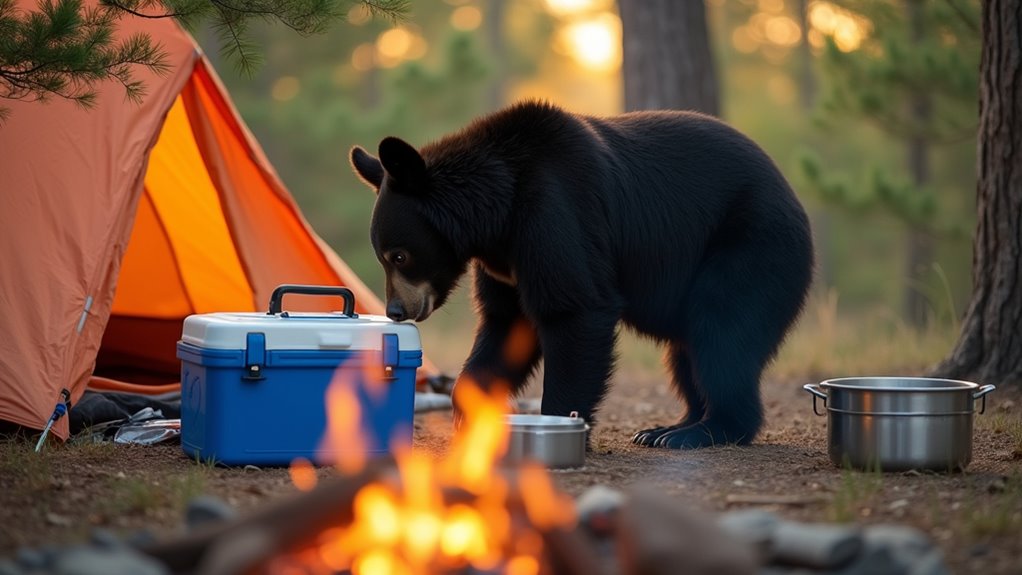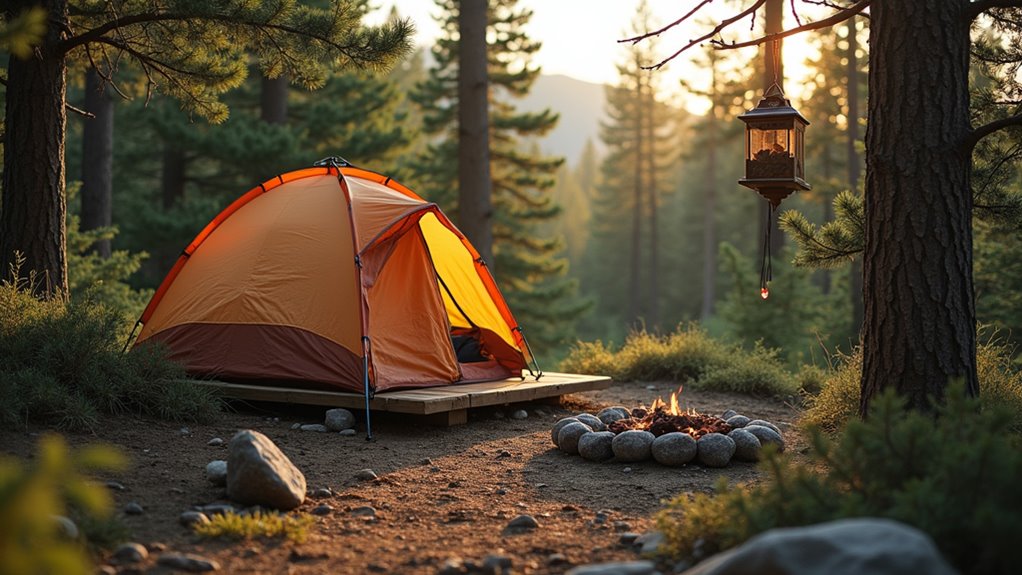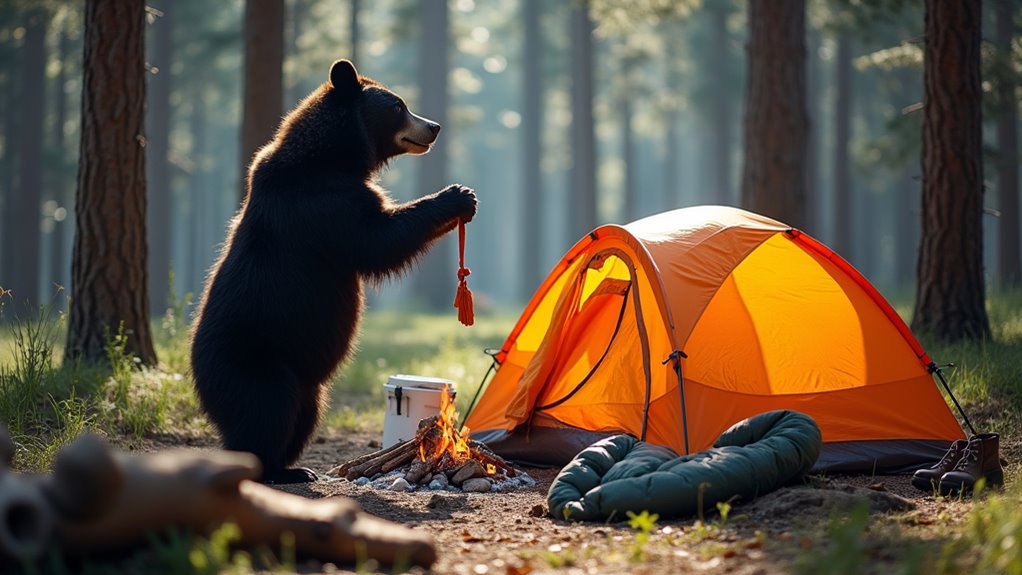Physical Address
304 North Cardinal St.
Dorchester Center, MA 02124
Physical Address
304 North Cardinal St.
Dorchester Center, MA 02124

Understanding wildlife behavior during summer camping trips could save your life, but most campers make these critical mistakes that attract dangerous animals.
You’re planning that perfect summer camping trip, but there’s one challenge you can’t ignore—wildlife encounters that could turn your peaceful getaway into a dangerous situation. While bears, raccoons, and other animals don’t mean to cause trouble, they’re naturally drawn to campsites for food and shelter. The good news is that most wildlife conflicts are completely preventable when you know the right strategies. Here’s what separates experienced campers from those who learn these lessons the hard way.

When you’re camping in the wilderness, recognizing wildlife behavior patterns can mean the difference between a memorable adventure and a dangerous encounter. Bears display aggressive postures by standing upright, making huffing sounds, or clacking their teeth. If you spot fresh tracks, scat, or claw marks on trees, you’re in active bear territory.
Mountain lions typically avoid humans but may stalk if they’re protecting young or feel cornered—watch for tracks with no claw marks and listen for growling.
Raccoons become bold around campsites, especially at night, rummaging through trash and food supplies.
Snakes often bask in sunny spots during cooler mornings and evenings.
Most wildlife gives warning signals before attacking: hissing, growling, raised fur, or direct staring. Trust these signs and back away slowly.
In high-altitude environments like the Himalayas, additional precautions become essential as the terrain and wildlife present unique challenges that require specialized camping techniques to ensure your safety.
Since bears possess an extraordinary sense of smell—seven times stronger than a bloodhound’s—you’ll need to treat every scented item as a potential attractant. Store all food, toiletries, trash, and cooking gear in bear-proof containers or hang them at least 12 feet high and 4 feet from tree trunks.
Never keep anything scented in your tent—not even toothpaste or deodorant. Cook and eat at least 100 yards downwind from your sleeping area. Clean dishes immediately and dispose of greywater away from camp.
If bear canisters aren’t available, use the counterbalance method: tie rope over a sturdy branch, hoist two equally weighted stuff sacks, and position them midway between trees. Always follow local regulations, as some areas require specific storage methods or provide designated food lockers.
Plus, consider using mosquito repellent strategies around your campsite, as the scents from insect control products can also attract bears if not properly stored.

Beyond securing your food properly, your choice of campsite location sets the foundation for a wildlife-free experience. You’ll want to avoid natural animal highways like game trails, water sources, and berry patches. Look for established campsites rather than creating new ones – animals learn where humans typically camp and adjust their patterns accordingly.
Set up camp in open areas where you can see approaching wildlife, avoiding dense brush or blind corners. Keep your sleeping area, cooking zone, and food storage triangle at least 100 yards apart from each other. Don’t camp directly under fruit trees or near obvious animal signs like scat, tracks, or claw marks on trees.
Choose higher ground when possible – many animals prefer valleys and drainage areas for nighttime movement. When selecting your campsite, also consider wind direction as it affects how your scent travels and can alert nearby wildlife to your presence.
While proper campsite selection forms your first line of defense, you’ll need specific gear to actively deter curious wildlife from entering your camp. Pack bear spray as your primary deterrent—it’s effective against most large animals and easy to deploy quickly.
Motion-activated lights startle nocturnal visitors and illuminate your perimeter without draining batteries constantly. Noise makers like air horns or bear bells create disturbances that encourage animals to retreat. A sturdy whistle serves double duty for emergencies and animal deterrence.
Consider portable electric fencing for extended stays in high-activity areas. Keep a bright flashlight handy for nighttime encounters, and pack extra batteries for all electronic devices. These tools work best when you’re familiar with their operation before heading into the wilderness.
For extended camping trips where wildlife encounters are more likely, plan lightweight meals that won’t leave strong odors or require extensive cooking that might attract unwanted visitors.

Having the right gear means nothing if you don’t know how to respond when you actually face a wild animal. Each species requires different tactics, and your reaction determines whether you’ll walk away unharmed.
Here’s what you should do during common encounters:
Remember that hot-weather camping brings increased wildlife activity as animals seek water sources and shelter during peak heat hours.
Even with proper preparation and correct response techniques, some wildlife encounters escalate beyond your control. When an animal injures someone, your priority shifts to immediate medical response and evacuation procedures.
First, secure the scene by moving everyone away from the animal’s location. Don’t attempt to pursue or kill the animal unless it’s actively attacking.
Apply first aid using your wilderness medical kit, focusing on controlling bleeding and treating shock. Document the incident with photos if safe to do so.
Activate your emergency communication plan immediately. Use satellite communicators, cell phones, or emergency beacons to contact rescue services. Provide exact GPS coordinates, injury details, and animal species involved.
If evacuation isn’t possible, prepare for extended care while maintaining constant communication with emergency responders until help arrives.
Before heading into the wilderness, research different camping styles to ensure you select locations and methods that minimize wildlife encounters while maximizing your safety preparedness.
You don’t want to become another statistic like the California family who lost their entire food supply to a black bear because they stored it in their car overnight. The bear broke three windows and destroyed their gear, turning their dream vacation into a nightmare. Follow these protocols religiously—hang your food properly, choose smart campsites, and carry deterrents. Your safety and wildlife’s well-being depend on your preparation and respect for their territory.